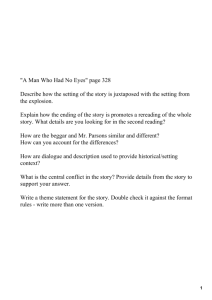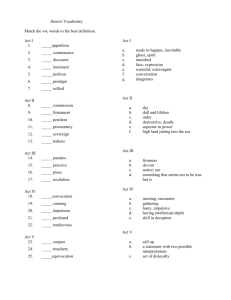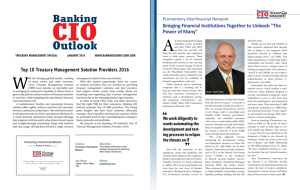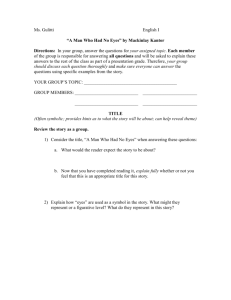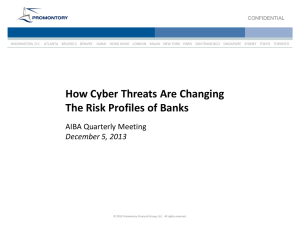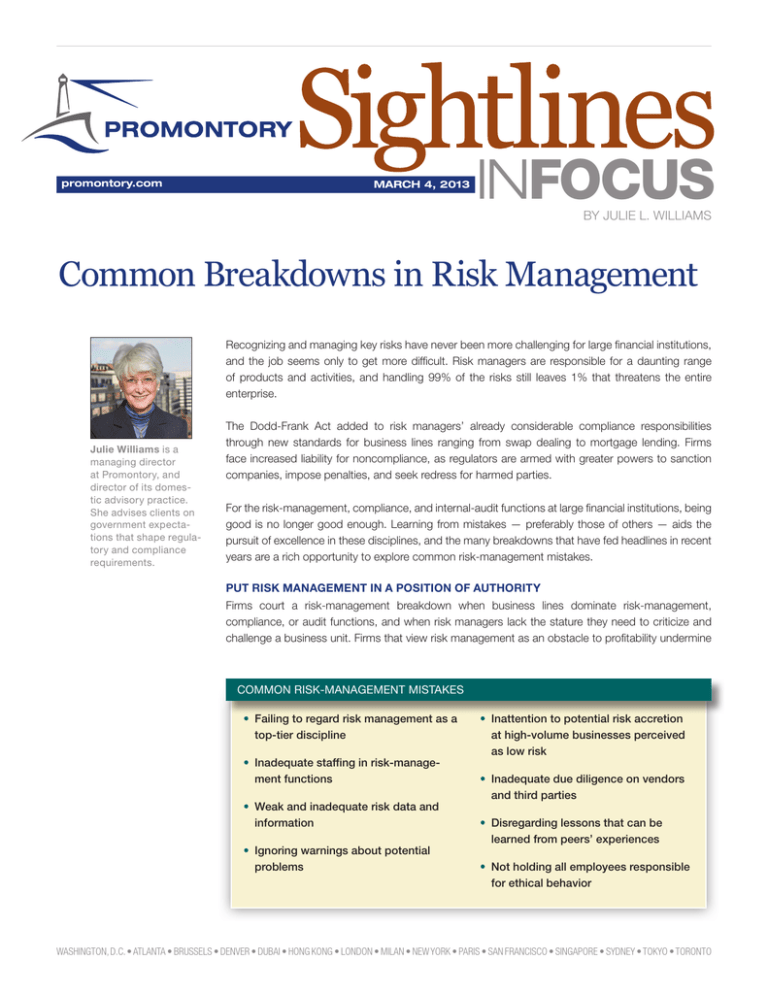
promontory.com
MARCH 4, 2013
INFOCUS
BY JULIE L. WILLIAMS
Common Breakdowns in Risk Management
Recognizing and managing key risks have never been more challenging for large financial institutions,
and the job seems only to get more difficult. Risk managers are responsible for a daunting range
of products and activities, and handling 99% of the risks still leaves 1% that threatens the entire
enterprise.
Julie Williams is a
managing director
at Promontory, and
director of its domestic advisory practice.
She advises clients on
government expectations that shape regulatory and compliance
requirements.
The Dodd-Frank Act added to risk managers’ already considerable compliance responsibilities
through new standards for business lines ranging from swap dealing to mortgage lending. Firms
face increased liability for noncompliance, as regulators are armed with greater powers to sanction
companies, impose penalties, and seek redress for harmed parties.
For the risk-management, compliance, and internal-audit functions at large financial institutions, being
good is no longer good enough. Learning from mistakes — preferably those of others — aids the
pursuit of excellence in these disciplines, and the many breakdowns that have fed headlines in recent
years are a rich opportunity to explore common risk-management mistakes.
PUT RISK MANAGEMENT IN A POSITION OF AUTHORITY
Firms court a risk-management breakdown when business lines dominate risk-management,
compliance, or audit functions, and when risk managers lack the stature they need to criticize and
challenge a business unit. Firms that view risk management as an obstacle to profitability undermine
COMMON RISK-MANAGEMENT MISTAKES
•Failing to regard risk management as a
top-tier discipline
•Inadequate staffing in risk-management functions
•Weak and inadequate risk data and
information
•Ignoring warnings about potential
problems
•Inattention to potential risk accretion
at high-volume businesses perceived
as low risk
•Inadequate due diligence on vendors
and third parties
•Disregarding lessons that can be
learned from peers’ experiences
•Not holding all employees responsible
for ethical behavior
WASHINGTON, D.C. • ATLANTA • BRUSSELS • DENVER • DUBAI • HONG KONG • LONDON • MILAN • NEW YORK • PARIS • SAN FRANCISCO • SINGAPORE • SYDNEY • TOKYO • TORONTO
these functions and put managers at a disadvantage in sustaining a conversation with business-line
executives about balancing risk and reward. A popular and practical solution is to make sure business
lines own the risks they take, but organizations should be careful about turning risk managers into
business partners who view their role more as enabling profitability than ensuring strong controls.
Risk inevitably catches up with those who ignore it. The initial costs associated with a breakdown are
followed by back-end expenses in rebuilding risk controls and restoring a diminished reputation with
clients, regulators, the media, and the public. But institutions can break the cycle by emphasizing
vigilance and by communicating the lasting importance of the risk-management function — even
when external conditions seem benign.
RECRUIT TALENTED MANAGERS, AND STAFF RISK FUNCTIONS APPROPRIATELY
Having talented professionals dedicated to risk management is essential. A firm must devote the
human resources to risk management that the importance of the function demands. Senior risk
managers must have the requisite skills and have risk-management experience commensurate with
the challenges faced by a large financial institution.
The best risk managers also accommodate changing risk profiles, and recognize that techniques that
work today may come up short only a few months later. Organizations should have risk-management
processes that are flexible and able to meet challenges that arise from circumstances beyond firms’
control.
The common perception of risk management as just an expense has fed a reluctance to spend money
on it, but companies need trained, adequately staffed functions to cover the size and nature of their
businesses. Staff turnover can add to this challenge, and adroit competitors poach risk-management
talent just as they poach talent in business lines. Firms should build in redundancies and avoid keyperson dependencies so that the departure of valued risk managers doesn’t leave gaps. Planning for
talent flight helps companies find replacements quickly.
THE RIGHT BALANCE OF RISK INFORMATION
Getting the right information into the right peoples’ hands is one of the trickiest risk-management
challenges large institutions face, and plenty of recent failures can be traced to communications
breakdowns in which senior risk managers and board members did not get the data they needed
— either because the information simply did not reach them, or was not gathered in the first place.
Large financial institutions must make sure they gather usable and relevant information on subjects
as varied as credit exposure, counterparty risk, and even the public’s views about the firms’ products
and practices. The entire picture is important, and firms should not hesitate to deliver it to senior risk
managers and the board for fear of causing offense.
The larger and more complex the firm, generally the more varied types of risk, including — and
perhaps especially — those that are hard to identify. Size and complexity increase the distance
between risk creators and those who need to receive, make sense of, and react to information on
risk. A bank of large size and high complexity can be tempted to look past risks from small functions,
and miss that they could inflict substantial losses on the entire enterprise. A good rule of thumb: If an
activity is so complicated that very few people can understand it, managing the associated risks may
be impossible. Firms may wish to reconsider whether to engage in the activity.
PROMONTORY Sightlines InFocus | MARCH 4, 2013 | 2
POTENTIAL BREAKDOWNS IN THE RISK-INFORMATION CYCLE
BOARD
RD
WEAK COMMUNICATION
The board might not set
effective risk tolerances
for management
MANAGEMENT
EMENT
MANAGEMENT INACTION
Management might fail
to act on the information
and rein in risk at the
business-unit level
FAILED DELIVERY
Usable risk information
may fail to reach the
board or management
The flow of risk information
can break down at any one
of several stages
RISK
MANAGERS
INADEQUATE COLLECTION
Risk managers may fail
to gather the necessary
risk information from
business units
BUS
BUSINESS
UN
UNITS
The amount of information delivered to senior risk managers and the board is as important as the type
of information. An overabundance of information might draw attention away from the risks that matter.
Too little information might leave out essential details and make the information conveyed unclear and
unusable. When a board is not getting the right amount of usable data, it cannot effectively challenge
a firm’s management and give direction on risk tolerance.
Technological challenges also lead to breakdowns in the flow of vital information. After mergers and
acquisitions, companies may be left with multiple risk-management programs and incompatible
technology platforms. Procedures for IT and platform integration should include risk management.
FOLLOW UP ON WHAT YOUR INFORMATION IS TELLING YOU
The failure to recognize and respond quickly to warnings about potential problems is another type of
risk-management breakdown. Internal audits underpin strong risk management, but firms may ignore
concerns identified in internal audits — often to their extreme detriment. Some warnings come from
outside the firm. Consumer-advocacy groups, for instance, can serve as valuable critics of a firm’s
retail practices. Activities that generate high volumes of customer complaints also merit additional
monitoring.
Banks must take their examiners’ warnings especially seriously. The bank supervision process is
designed to identify and fix problems early. The goal of supervision is sound banking, not to be merely
punitive. When bank examiners flag matters requiring attention — “MRAs” — it is often a firm’s best
chance to fix a problem before it evolves into an enforcement matter. Banks that use the examination
process constructively — to identify operational weaknesses and promptly rectify them — improve
their odds of avoiding serious risk-management lapses.
PAY ATTENTION TO SEEMINGLY LOW-RISK FUNCTIONS
Simple, small errors can have outsized consequences if they are repeated frequently enough —
witness problems with mortgage-foreclosure documentation. Supervisors have begun to ask
PROMONTORY Sightlines InFocus | MARCH 4, 2013 | 3
whether large banks have other, similar processes for other types of products. Firms with relatively
straightforward but high-volume businesses of any sort should be mindful that the marginal risk of
each transaction over time can accrete, eventually constituting a messy problem. Institutions should
probe these businesses for the fault lines, which often require unconventional thinking to spot.
KEEP AN EYE ON VENDORS
Banks have never been more liable than they are today for the practices of the vendors they select
to carry out important functions. Prudential regulators and the Consumer Financial Protection Bureau
have recently taken actions against banks and thrifts for products and services provided to their
customers by third parties, as well as for due-diligence failures in selecting and monitoring those third
parties. The CFPB also told companies in a bulletin last spring that they can be held liable for the
actions of firms with which they contract.
A firm that “deconstructs” its operations — that is, it uses a third party to perform a function that the
institution might otherwise have performed — must think of those operations as if the firm itself carried
them out. Due diligence must not end with vendor selection; in the eyes of regulators, vendor due
diligence is a matter of continuously managing risk and verifying that the third party’s practices meet
the institution’s standards.
MONITOR AND LEARN FROM YOUR PEERS
Banks that recognize and promptly correct their own lapses can also benefit from understanding
other firms’ lapses. When an industry peer suffers a high-profile breakdown in risk management,
banks should assess their own risk management and controls for similar operations. Risk managers
and audit committees should constantly watch peers for signs of trouble and ask whether their own
company is prone to the same risks — and if so, whether it has a process in place to gauge the type
of risk that led to the problem.
DOING THE RIGHT THING
Perhaps the best safeguard against risk-management lapses is a firmwide culture that encourages
employees always to make a good-faith effort to do the right thing. Many of the recent high-profile
enforcement actions against U.S. and global financial institutions resulted from actions by employees
who lost sight of this principle. Countless individual careers, several major institutions, and the banking
industry have suffered severe reputational and financial damage as a result.
Responsibility for a firm’s culture resides at the top of the organization. It is up to management and
the board — through personnel and compensation decisions, the handling and use of consumer
complaints, and other means — to instill sound ethics and create a sustainable enterprise. Subcultures
within a firm lacking that commitment need to be identified, monitored, controlled, and ultimately,
corrected. Risk managers play a role here, but their best efforts must be coupled with a firmwide
commitment to fair conduct.
CONCLUSION
Financial institutions serve their clients by accepting risk, and the past few years have offered constant
reminders about the consequences of failing to manage it. Policymakers are naturally focused on risk
management, compliance, and internal audit given the repeated breakdowns of recent years, but it’s
up to the companies to make sure that their own vigilance isn’t cyclical. Perceptions of risk priorities
are variable; the principles that guide its management are constant.
PROMONTORY Sightlines InFocus | MARCH 4, 2013 | 4
Contact Promontory
For more information, please call or email your usual Promontory contact, or one of those listed below:
Konrad Alt
Managing Director, San Francisco
kalt@promontory.com
+1 415 986 4160
Patrick Parkinson
Managing Director, Washington, D.C.
pparkinson@promontory.com
+1 202 384 1052
Michael Dawson
Managing Director, Washington, D.C.
mdawson@promontory.com
+1 202 384 1080
Wayne Rushton
Managing Director, Washington, D.C.
wrushton@promontory.com
+1 202 384 1015
Kathy Dick
Managing Director, Washington, D.C.
kdick@promontory.com
+1 202 384 1092
William Rutledge
Managing Director, New York
wrutledge@promontory.com
+1 212 365 6984
David Gibbons
Managing Director, Washington, D.C.
dgibbons@promontory.com
+1 847 707 4279
Julie Williams
Managing Director and Director of Domestic
Advisory Practice, Washington, D.C.
juwilliams@promontory.com
+1 202 384 1087
Susan Krause Bell
Managing Director, Washington, D.C.
skrausebell@promontory.com
+1 202 384 1151
To subscribe to Promontory’s publications, please visit promontory.com/subscribe2.aspx
Follow Promontory on Twitter @PromontoryFG
Promontory is a leading strategy, risk management, and regulatory compliance consulting firm for the financial services industry. Promontory’s professionals have
deep and varied expertise gained through decades of experience as senior leaders of regulatory bodies and financial institutions. Promontory assists clients in
meeting regulatory requirements and in enhancing governance, risk management, strategic plans, and compliance programs.
Promontory Financial Group, LLC
801 17th Street, NW, Suite 1100, Washington, DC 20006 Telephone +1 202 384 1200 Fax +1 202 783 2924 promontory.com
© 2013 Promontory Financial Group, LLC. All Rights Reserved.
PROMONTORY Sightlines InFocus | MARCH 4, 2013 | 5
3/13/2013
UNC SCHOOL OF LAW
BANKING INSTITUTE 2013
OPERATIONAL RISK
Richard J. Parsons
Author, Broke: America’s Banking System
March 22, 2013
Copyright 2013, Richard J. Parsons
2
Goals for the Session
1. Operational Risk 101 – gain working knowledge
of the language and tools of Operational Risk
2. Operational Risk 201 – understand a few critical
components of an effective Operational Risk
Management Program
3. Operational Risk 301 – be aware of hot topics,
discuss emerging risks, “fat” tail losses, 10X
Risk, and future of Operational Risk
Management disciple
1
3/13/2013
Copyright 2013, Richard J. Parsons
3
101
• Operational Risk 101, gain working knowledge
• History of Operational Risk as a risk discipline
• Supervisory guidance, key sources
• Definitions, event type categories, and four data
elements
• Approaches to quantification of capital
Copyright 2013, Richard J. Parsons
4
Basel II
• It all starts with Basel Committee on Banking Supervision
• Published Basel II in June 2004 to create an international
standard to determine how much capital banks need
• Rule of thumb: the greater the risk taken, the higher the
capital
• Final version separated Operational Risk from Credit Risk
• BCBS introduced in 2004 a capital charge for Operational
Risk as part of the new capital adequacy framework
• Basel has periodically updated Operational Risk guidance
2
3/13/2013
Copyright 2013, Richard J. Parsons
5
Why did BCBS Add a Capital Charge
Operational Risk?
Probably…
• Barings (1995: $1.4 billion Nikkei Futures)
• National Australia Bank (2004: A$360 million
foreign currency trading)
• 9/11/2001
• Globalization
• Deregulation
• Technology
Copyright 2013, Richard J. Parsons
6
Basel Committee Definition
Definition of Operational Risk
• Operational risk is defined as the risk of loss resulting
from inadequate or failed internal processes, people
and systems or from external events.
• This definition includes legal risk, but excludes
strategic and reputational risk.
• Legal risk includes, but is not limited to, exposure to
damages, fines, penalties, or punitive damages
resulting from civil cases and supervisory actions.
3
3/13/2013
Copyright 2013, Richard J. Parsons
7
Methods of Operational Risk
Capital Measurement
• Basel II has given guidance to 3 broad methods of capital
calculation for Operational Risk
• Basic Indicator Approach - based on annual revenue of the
Financial Institution
• Standardized Approach - based on annual revenue of each of
the broad business lines of the Financial Institution
• Advanced Measurement Approaches - based on the internally
developed risk measurement framework of the bank adhering
to the standards prescribed (methods include IMA, LDA,
Scenario-based, Scorecard etc.)
Copyright 2013, Richard J. Parsons
8
Basel II Event Type Categories
• Internal Fraud - misappropriation of assets, tax evasion, intentional
mismarking of positions, bribery
• External Fraud- theft of information, hacking damage, third-party theft and
forgery
• Employment Practices and Workplace Safety - discrimination, workers
compensation, employee health and safety
• Clients, Products, & Business Practice- market manipulation, antitrust,
improper trade, product defects, fiduciary breaches, account churning
• Damage to Physical Assets - natural disasters, terrorism, vandalism
• Business Disruption & Systems Failures - utility disruptions, software failures,
hardware failures
• Execution, Delivery, & Process Management - data entry errors, accounting
errors, failed mandatory reporting, negligent loss of client assets, and failure
to adhere to internal policies and limits.
4
3/13/2013
Copyright 2013, Richard J. Parsons
9
AMA: Four Fundamental Elements
1. Internal (Loss) Data
2. External (Loss) Data
3. Scenario Planning
4. Business Environment and Internal Control
Factors
Copyright 2013, Richard J. Parsons
10
Insurance
• BCBS stipulates a number of requirements before
insurance can be counted as a mitigant, for
example:
• The insurance company must have a rating of A (or
equivalent).
• The policy must be no less than one year in duration
• Cancellation requires 90 days notice
• Must not have exclusions triggered by bank failure of
regulator action
5
3/13/2013
Copyright 2013, Richard J. Parsons
11
201
Operational Risk 201, discuss five drivers of
effective Operational Risk Management
• Clear Roles and Responsibilities, with emphasis on
•
•
•
•
Governance
The role of the Board of Directors
The right KRIs
Scenario Analysis
Emerging External Risk management process
Copyright 2013, Richard J. Parsons
12
Basel June 2011: “Principles for the
Sound Management of Operational Risk”
Detailed descriptions of roles for:
• Board of Directors
• Senior Management
Detailed descriptions for processes:
• Risk Management Environment
• Monitoring and Reporting
6
3/13/2013
Copyright 2013, Richard J. Parsons
13
Basel Committee -- June 2011
First Four Principles
1. The Board should take the lead
2. Banks should develop a framework
3. Board shall review the framework periodically
4. Board should approve a risk appetite and have
tolerance statement
Copyright 2013, Richard J. Parsons
14
301
Operational 301, discuss macro US and global issues
related to the management of banks
• “Fat” Tail Losses
• “10X Risk”
7
3/13/2013
Copyright 2013, Richard J. Parsons
15
The Big Risks
• Form Over Substance
• Failing to Focus on Critical Few Activities
• Making ORM a Quantitative Exercise
Copyright 2013, Richard J. Parsons
16
ORX 2011 Operational Loss Analysis
Events: 36,259
Total Losses: € 25.1 billion
Average: € 620 million
8
3/13/2013
17
Copyright 2013, Richard J. Parsons
ORX Reported OpLoss Events 2011
40000
35000
30000
#
o 25000
f
E 20000
v
e
n 15000
t
s
10000
5000
0
20 k ‐ 1mm
1mm ‐ 10 mm
10 mm +
Loss Categories in Euros
18
Copyright 2013, Richard J. Parsons
ORX Losses 2011
25.1 MM Euros
25,000,000,000
20,000,000,000
15,000,000,000
10,000,000,000
5,000,000,000
0
20 k ‐ 1mm
1mm ‐ 10 mm
10 mm +
Loss Categories in Euros
9
3/13/2013
Copyright 2013, Richard J. Parsons
19
What is“10X Risk”?
• Origin
• Definition
• Implications
Copyright 2013, Richard J. Parsons
20
10X Risk in the U.S.
6 Bank Panics in 19th century
Panic of 1907
9000 bank failures Great Depression
3000 failures Banking Crisis of 1985-1992
-- 2008 in 11 states
460 + bank failures since 2008
-- 72% in 10 states
10
3/13/2013
Copyright 2013, Richard J. Parsons
21
Why do banks fail?
Years of Regulators’ Material Loss Reviews reveal:
• Board governance weak – directors lack bank skills
• Management lacks skill IMMR risks
• Controls are inadequate
• Strategy: Bank lacks strategic plan, or if it has one, it is
inadequate
Copyright 2013, Richard J. Parsons
22
Bank Failures are
Operational Risk Failures
• Board = People and Processes
• Management = People and Processes
• Controls = Processes and Systems
• Strategy = People and Processes
11
3/13/2013
Copyright 2013, Richard J. Parsons
23
The Future of Bank Risk Management?
10X Risk vs. X Risk
• Focus on Operational Risk?
• Common Sense: Major in the Majors
• 10X
• Fat Tail
Copyright 2013, Richard J. Parsons
24
A Shameless Plug
Broke: America’s Banking System: Common
Sense Ideas to Fix Banking in America
About basic banking in the U.S.
Published by The Risk Management Association
Available March 20, 2013
at www.rmahq.org and www.amazon.com
12

